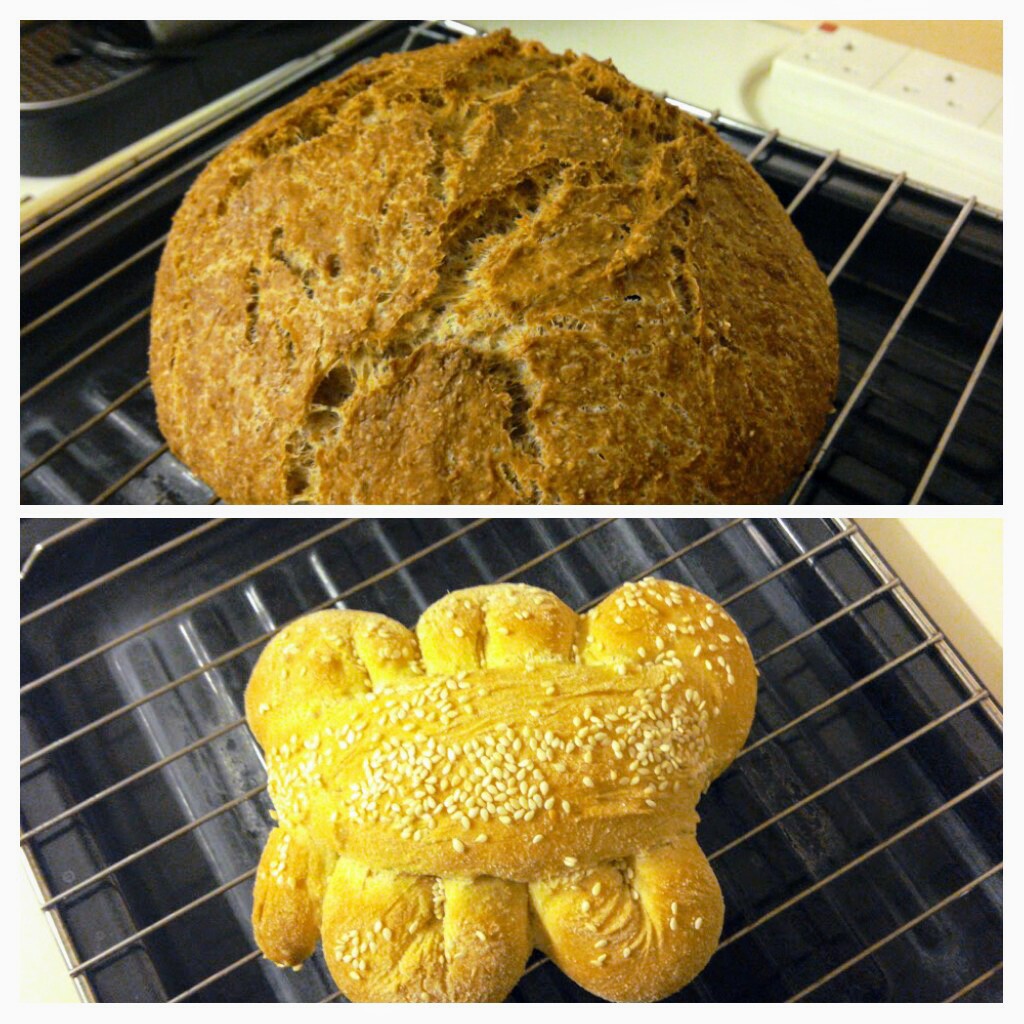
Failure? Well, it LOOKS like it...

Well, all of you evil influences managed to tempt me off of my planned path of simple formulas (with some experiments of percentages and timing just to figure out what works best here), and off in to the crazy territory of the more complex recipes...
I can't say that I am really ready for it, but - well, that's part of the fun!
For my "base" bread for the week, I stuck with the 50% whole grain that I enjoyed from last week, but scaled down and with a different preferment percentage and timing. I haven't quite developed the feel for fermenting / proofing yet, so it was slightly under-proofed, and I didn't get as much caramelizing as I would have liked, but it's still just fine for our "base":

No crumb shot yet, but I'm sure it'll be just a bit more dense than last time. I've learned that I need to either keep the percentage of levain higher (pre-fermented flour was just 10% of total flour weight), proof at a higher temperature, or allow for more time in my schedule for this to bulk ferment. No worries, and not a "failure" - just not quite as much oven-spring as I would have liked.
Edit to add crumb shot:

As for the other experiment, well, it sure LOOKS like a failure! No oven spring, the scoring basically disappeared, and it looks like an oversized pancake:

As I stood there today, explaining to my husband what a total failure this was (completely under-fermented, under-proofed) and how I had royally messed it up (trying to go by the clock and not the dough - and being far too concerned about the prospect of OVER proofing), he raised an eyebrow and inquired whether I realized that I had basically inhaled 3 pieces of the "failure" while we were talking... It may LOOK bad, but folks - this thing is freakin' CANDY!

Yeah - so I went with a toasted barley porridge, soaked chopped figs, toasted almonds and wheat germ, 5g each of white and red rye malt, and --- yeah. It's candy. It actually might be a GOOD thing that I messed up the texture, since I imagine that if it had turned out as a SUCCESS then I'd have inhaled the whole thing by now!
In my opinion, one of the great things about experimenting with bread is that there really aren't any "failures" - even the worst results can be used as bread crumbs or added to a bread pudding or used as altus in a future bake. Gotta have fun with it!
| SUMMARY | |||||
| WEIGHT (G) | BAKER % | ||||
| TOTAL MILLED FLOUR | 795 | 100.00 | |||
| Flour in Levain (whole grain rye) | 75 | 9.43 | |||
| Flour in Autolyse | 720 | 90.57 | |||
| (340g hard red wheat, 280g all purpose, 100g whole spelt) | |||||
| Added Flour in Final Mix | 0 | 0.00 | |||
| TOTAL HYDRATION | 705 | 88.68 | |||
| Water in Levain | 75 | 9.43 | |||
| Water in Porridge / Soaker | 110 | 13.84 | |||
| Water in Autolyse | 520 | 65.41 | |||
| Added Water in Final Mix | 0 | 0.00 | |||
| Other liquids | 0 | 0.00 | |||
| TOTAL DRY ADDERS | 273 | 34.34 | |||
| Toasted Additions (60g almonds 30g wheat germ) | 90 | 11.32 | |||
| Soaker Additions (60g barley, 3g salt, 120g soaked figs) | 183 | 23.02 | |||
| Autolyse Additions | 0 | 0.00 | |||
| Final Mix Additions | 0 | 0.00 | |||
| SALT | 15 | 1.88 | |||
| FINAL DOUGH | 1788 | 224.90 | |||
| FINAL FLOUR | 795 | 100.00 | |||
| FINAL HYDRATION | 595 | 74.84 | |||
| (NOT including water absorbed by grains / fruit in porridge / soaker) | |||||
| METHOD | |||||
| DAY 1: | |||||
| 1 | Build Levain with a 3 stage build: | Stage 1 | Stage 2 | Stage 3 | |
| Starter | 6 | ||||
| Flour | 11 | 22 | 44 | ||
| Water | 11 | 22 | 44 | ||
| Plan for final dough mix 12-16 hours after stage 3 feed if leaving at room temperature, or after | |||||
| doubling at room temp then refrigerating | |||||
| 2 | Toast almonds and wheat germ then crush almonds. Cook barley in 180g boiling water for 35 min | ||||
| giving 120g cooked total (60g water). Soak chopped figs in 120g water (use this water in autolyse) | |||||
| DAY 2: | |||||
| 1 | Combine any prepared toasted additions, soakers/scalds/porridges, and | ||||
| all flours with water in a rough mix. Cover and allow to sit at room temperature | |||||
| for 1 to 2 hours. Sprinkle salt on top so don't forget it. | |||||
| 2 | Spread levain over top of autolyse and thoroughly mix in. Add up to 25g more water if needed. | ||||
| Allow to rest, covered, for 10-20 minutes. | |||||
| 3 | Thoroughly knead dough in bowl for 10-15 minutes, then allow to rest, covered, for another | ||||
| 15 minutes. Knead again until dough is smooth and forms cohesive ball (about 5-10 minutes). | |||||
| Place in to clean fermenting container and cover for bulk fermentation. | |||||
| 4 | Do stretch-and-fold on dough every 30 minutes for first 2 hours (30/60/90/120) minutes, as | ||||
| needed. Add in another couple of sets at 150/180 minutes if necessary. After that, allow | |||||
| overnight in the fridge (look for 30-50% volume increase). | |||||
| SF@ 2:15, 2:45, 3:15, 3:45, in to fridge at 4:00 | |||||
| DAY 3: | |||||
| 1 | Remove proofing bin from fridge and allow to come to room temperature and finish proofing. | ||||
| 2 | Release dough from fermenting container on to clean work surface. Use damp hands and | ||||
| damp bench knife to pre-shape. Cover and allow to bench rest for 30 - 60 minutes. | |||||
| 3 | Very lightly flour hands, work surface, and surface of dough. Flip over, degas, and do final | ||||
| shaping. Place seam down in parchment lined banneton, cover with plastic, and | |||||
| allow to proof at room temperature (watch for level - might be up to 3 or 4 hours) | |||||
| Bake when finger poke returns veeeery slowly. | |||||
| 4 | Preheat oven to 475 degrees with roasting pan placed on cookie sheet inside. Wait at least | ||||
| 20 minutes after oven chimes that pre-heat is finished. | |||||
| 5 | Score top of dough, take lid off roaster, and quickly place dough in to roaster with the | ||||
| parchment paper. Spritz inside roaster with water, replace cover, and drop temp to 450 degrees. | |||||
| Bake covered for 20-25 minutes, then drop temp to 425 degrees and bake uncovered for | |||||
| 35 to 45 minutes (until internal temp is 208-210 F). Allow to cool for 24 hours before slicing. | |||||
| Suggest: allow to cool for 10 min in oven with temp off and door opened before removing |
| ||||











